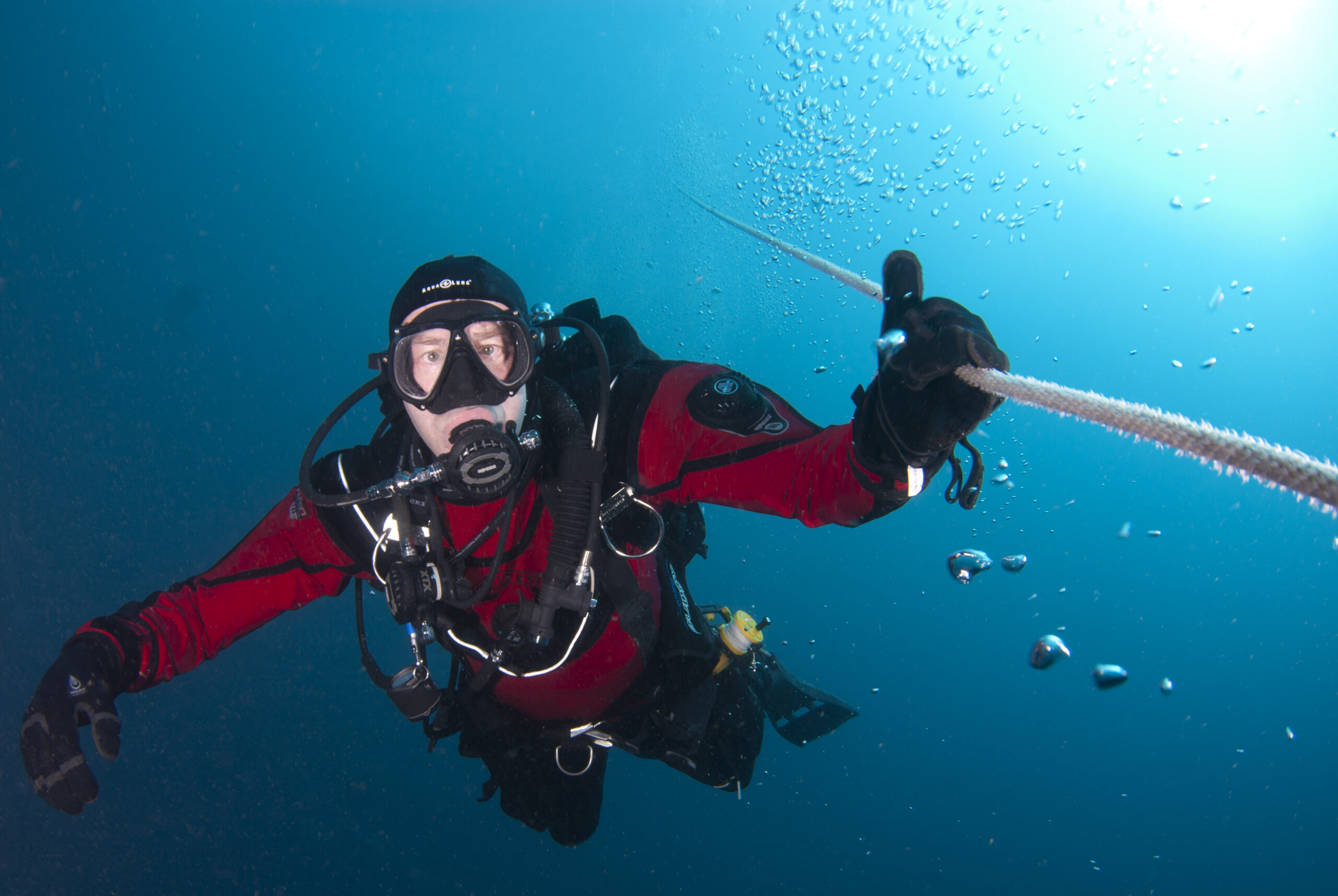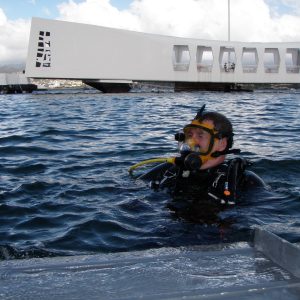Your cart is currently empty!
Combined Advanced Nitrox & Helitrox Diver
Course Price: $1,800.00
Now Due: $900.00
Helitrox is a bottom dive gas mixture with no more than 35% Helium, and an Oxygen percentage no less than 21%. Advanced Nitrox is the use of Higher Oxygen concentrations up to 100% Oxygen for the purposes of decompression. This combined course is fast paced, no BS training specifically designed for recreational divers with some experience diving doubles or sidemount, to introduce them to both mandatory decompression, and the use of Helium.
I no longer teach straight TDI Decompression Procedures, as I feel that it is more difficult to leave Helium out of the academic lessons of Deco Diving, than it is to include it. The training is pretty much the same, but the academics are better with the value added of understanding Helium. Students will have the option of diving Helium on the last day of class. In this 4 day class. We will spend our mornings diving, when the weather is best, and after lunch we will be in the classroom to debrief and work on the serious academics of decompression diving, Helitrox, and risk management.
Description
This is an intensive 4 day, 7 dive technical Scuba diving class that combines training for two TDI certifications, Advanced Nitrox and Helitrox Diver.
Student divers who compete the class and meet the requirements, will receive TDI certifications for Advanced Nitrox and Helitrox Diver. Your tuition does not buy your certifications, you have to earn them, by meeting the TDI Standards. If you cannot meet the minimum standards, I will not abandon you, and we will figure out what we need to do to get your skills to where they need to be. The Helitrox certification is a prerequisite for the TDI Advanced Wreck, Basic Trimix, and Extended Range (Deep Air) courses.
In preparation for class, student divers will have to complete the three TDI Online training courses and exams for Advanced Nitrox, Decompression Procedures. and Extended Range/Trimix. Students will also have to sign the TDI Training Liability releases, fill our a Medical Statement, and get Divers Accident Insurance. A few days before Day One and the start of class, I will schedule a 90 minute Zoom Call with the Students at a time convenient for all. We will go over the Dive Plan for Day One, and Student Divers can ask any questions they might have.
Class size is limited to 4 student divers, and you will need to make a deposit to hold your seat in class. I will be instructing with a second instructor in the water. Our primary focus is on the safety of the student divers, and we provide the kind of supervision and attention needed to allow you to safely build your decompression diving foundation.
Our Dives will be open ocean, decompression wreck dives with a maximum depth of 150 feet. For Day One, our max depth will be 75 feet. We will do two dives off of our single set of doubles. If you need more gas, we can top off. You will be busy on our dives.
If you do not yet have all of your personal equipment, rental equipment is available. For some divers, this class is an opportunity to try different gear, and discover what will work for them without buying the wrong item multiple times? We want to help you avoid buying gear that you will not be happy with, or it will not do what you want it to. If you do not have any equipment, or twin cylinder experience, an Intro to Tech course would be more suitable for you.
Required Equipment
- Wetsuit – Depending on the time of year, and personal preference, either a 3mm or a 5mm wetsuit. Personally, I also like a hooded vest. Try it on before you buy, because the sizes are sometimes crazy??
- Fins and Booties – Long blade Freediving fins are not suitable. Open heel fins work best. I do not wear booties, I wear mid height Marine Assault boots, either Altama or Woobies and XL size fins. They are made for. salt water.
- Mask – A good mask that fits you, is essential.
- Gloves – Neoprene gloves work, but they are less functional and practical than something like “gardening gloves”, or Dyneema ”Cut Resistant” Gloves. Simple hand protection is what you need, and if you already have gloves, they will most likely work.
- Cylinders – IMHO, back mounted double steel cylinders with a manifold are the best primary cylinder setup for Open Circuit deco diving. Side mounts, or Twin K Valves will also work. You will need cylinder(s) with volume(s) appropriate for dives planned to 150’, considering your individual SAC rate. All cylinders are to be labeled according to TDI Standards, which means Nitrox cylinders need to be labeled for Nitrox. An O2 clean Deco Cylinder is required for the class, rigged to carry. Bring whatever size you want, but most students use aluminum 40’s. Typically, I will utilize an AL72 for classes. Twin Faber LP85’s seem to work for the majority of divers, and they can be rented for this course here in Florida.
- Regulators
- You will need a Primary and a Primary Backup regulator on your Bottom Gas supply. The major brands all make quality regs for deeper diving.
- You will need an O2 clean deco gas regulator. My back gas regs are top tier regs, my deco reg is O2 clean but just a simple reg, because I only use it in shallow water.
- You need a single SPG connected to the first stage regulator, for each gas supply. It is not necessary to have two SPG’s on your Bottom Gas
- You will need a “Necklace” or some other way to hold your backup second stage regulator in place around your neck. I prefer using simple 1/8″ bungee and not the rubbery, store bought ones where the regulator keeps falling out. A bungee necklace just works better.
- Backplate – You need a backplate with straps or harness. Backplates come in Stainless Steel and Aluminum. Stainless is heavier, and to reduce weight, some have cutouts. In general, Drysuit divers want heavier plates, and Wetsuit divers want lighter plates. Brand is not so important. Personally, I like Straps over Harness, for a variety of reasons. I can help you rig your straps. Don’t cut them to fit, until we meet.
- Wing – You need a BCD suitable for the Open Water environment in your particular setup. A typical Wing will have 45# to 65# of lift, and IMHO 45# is ideal for most divers. I like the Dive Rite Rec Wing in 45# either single or with dual bladders. For deeper dives, divers really need an alternate ascent plan, in the event of a Wing Failure. Your best options are dual bladder, Drysuit, or dedicated SMB/Lift Bag, in that order.
- Dive Computer – For this class, a Shearwater Dive Computer is mandatory. You also will need a backup computer or depth gauge. The Teric is okay for backup, but not acceptable as a Primary as it does not give you all the dive data of the Perdix/Petrel. In class, we will download your dives on the Shearwater, and dissect them. This makes the Shearwater a valuable learning tool for you, and it will make a definite difference in the way you dive. If you do not have a Shearwater, you can rent one.
- Dive Planner – You need a means to plan your dives using your dive computer, Smart Phone, laptop, or tablet. The algorithm of your planner should match the algorithm of your dive computer, and we will use Bühlmann ZHL16-C GF. If you want to get Multi Deco, get Multi Deco or you can try MV Planner for free. It is by the same Multi Deco guys, but no-frills shareware and a different algorithm. Try playing around with it for free.
- Lights – One Primary is fine.
- SMB – You will need a good SMB, and you will use it. Bring what you have for an SMB, but no Safety Sausage. We will be hanging on our SMB’s for Deco. Personally, I love the Carter 25# Spearfishing Float with a CO2 inflator. As an instructor, I am responsible for the students, so I can operate the Spearfishing Float and hand off to a student very quickly, in a couple of seconds.
- Spool or Reel – This is to use with your SMB, 100’ minimum line. Bring everything you already own, or get a cheap aluminum spool off of Amazon. You will know more of what you want, after a couple of dives. I like the Dive Rite Slide Lock reel.
- Cutting Device – Bring a knife, not something “like a knife”. Make it sharp.
- Slate and Pencil – We want to make notes on our dive plan, or take notes about what happens on a dive.
- Jon Line – I will supply you with a Jon Line, you supply the Bolt Snap. Feel free to bring your own Jon Line, if you like.
- Bolt Snap Clip – Bring two spare “Double Enders”, “Double Dogs”, Bolt Snaps, or whatever you call them. I used to say, bring one, but you really need two.
- Weight – In theory, you will not need any weight if you are diving wet. If that is untrue, we will deal with it. If you are diving dry, bring a belt or harness, and we have weight.
Course Schedule
4 Days of Training, 7 OW Ocean dives.
Day 1 – AM Two Wreck Dives 75′, PM Classroom for Debrief and academics.
Day 2 – AM Two Wreck Dives 100′, PM Classroom for Debrief and academics.
Day 3 – AM Two Wreck Dives 130′, PM Classroom for Debrief and academics.
Day 4 – AM Single Wreck Dive 150′, PM Classroom for Debrief and academics.


